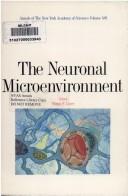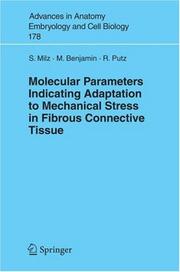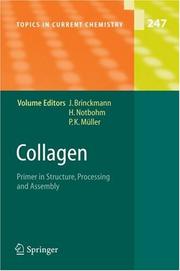| Listing 1 - 8 of 8 |
Sort by
|
Book
Year: 2016 Publisher: Bruxelles: UCL. Faculté de médecine et de médecine dentaire,
Abstract | Keywords | Export | Availability | Bookmark
 Loading...
Loading...Choose an application
- Reference Manager
- EndNote
- RefWorks (Direct export to RefWorks)
Liver fibrosis is the main adverse effect of chronic liver disease and results from the excess deposition of scar tissue. Clinical data show that aging enhances the vulnerability to liver injury and the severity of the fibrosis (1-4). The aim of this work was to confirm these data in an animal study and to understand the underlying mechanisms. Seven-weeks-old male C57BL/6J mice were purchased as the young mice and 15-months-old for the old mice. CCl4, diluted in corn oil, intra-peritoneal injections were performed 3 times a week for 2 weeks, to induce liver fibrosis. Mice in the control group received injections of corn oil only. Mice were sacrificed 48 hours (peak of fibrosis) or 96 hours (fibrosis reversibility) after the last CCl4 injection. Results show that old mice developed a more severe liver fibrosis than the young mice, according to the analysis of a Sirius Red staining on liver sections. The quantification of alpha SMA (marker of activated stellate cells) mRNA and type I collagen (scar matrix protein) suggests that the more severe fibrosis in old mice was not due to an enhanced pro-fibrotic process. But, a lower expression of MMP-13 and its CXCL9 inducer in elderly mice suggests a lesser clearance of hepatic fibrosis related to age. After using a F4/80 immunochemistry to evaluate liver macrophage infiltration and PCR to assess the macrophage's phenotype, our results showed that pro-resolutive macrophage gene markers (MMP-13, CXCL9) are higher in young mice while pro-inflammatory and pro-fibrotic markers (TGF-beta) are higher in old mice. This infiltration of pro-resolutive macrophages suggests a more dynamic remodeling process of the ECM. We were also able to highlight that the proportion of heavily cross-linked collagen fibers (visualized under polarized red light) was significantly higher in old mice at peak of fibrosis. It promotes excess accumulation of thicker fibrotic septa and opposes a resistance to ECM proteolytic degradation. These experiments allowed us to observe a more severe fibrosis in old mice compared to young mice by a reduction of the fibrosis resolutive mechanisms, including a reduced MMP-13 production in old mice, a preferential recruitment of liver macrophages, keeping a pro-fibrotic phenotype rather than a pro-resolutive phenotype and finally by a higher rate of cross-linked collagen fibers make the degradation of the extra cellular matrix more difficult. La fibrose hépatique est le principal effet négatif d'une agression hépatique chronique et résulte d'un excès de dépôt de tissu cicatriciel. Les données de la littérature décrivent l'âge comme un facteur de risque pour le développement et la sévérité de la fibrose hépatique chez l'homme (1-4). L'objectif de ce travail était de confirmer ces données humaines dans un modèle animal et de comprendre les mécanismes impliqués. Le design de l'expérimentation animale était le suivant : nous avons utilisé des souris C57BL/6J mâles âgées de 7 semaines pour les souris jeunes et de 15 mois pour les souris âgées. Nous leur avons injecté 3 fois par semaine durant 2 semaines du CCl4 dilué dans de l'huile de maïs en intra-péritonéal induisant ainsi une fibrose hépatique ; le groupe contrôle ne recevant que des injections d'huile de maïs. Le sacrifice des souris a eu lieu 48h (pic de fibrose) ou 96h (réversibilité de la fibrose) après la dernière injection de CCl4Les résultats obtenus témoignent d'une fibrose hépatique plus sévère chez les souris âgées comparativement aux jeunes, grâce à une analyse de morceaux de foie au Rouge Sirius. Une quantification de l'ARNm de l'alpha-SMA (marqueur des cellules stellaires activées) et du Collagène de type I (protéine de la matrice cicatricielle) nous indique que cette fibrose plus sévère chez les souris âgées ne vient pas d'un processus pro-fibrotique plus important. Par contre, une moindre expression de MMP-13 et de son inducteur CXCL9 chez les souris âgées suggère une moindre clairance de la fibrose hépatique liée à l'âge. Egalement, après avoir utilisé un immunomarquage F4/80 pour évaluer l'infiltration des macrophages au niveau du foie et des PCR pour caractériser le phénotype des macrophages, nos résultats nous ont révélé que l'expression des marqueurs de macrophages pro-résolutifs (MMP-13, CXCL9) est plus haute dans le groupe des jeunes tandis que l'expression des marqueurs pro-inflammatoires et pro fibrotiques (TGF-beta) est plus importante dans le groupe des souris âgées. Cette infiltration de macrophages pro-résolutifs des foies jeunes permet un remodelage de la matrice extracellulaire (MEC) plus dynamique. Par ailleurs, nous avons mis en évidence que la proportion des fibres de collagène fortement réticulées (visualisées en rouge sous lumière polarisée) est significativement plus élevée chez les souris âgées au moment du pic fibrotique. Cela promeut l'accumulation excessive de septa fibrotiques épais et confère une résistance à la dégradation protéolytique de la MEC. Ces expérimentations nous ont donc permis de conclure qu'une fibrose plus sévère est observée chez les souris âgées par rapport aux jeunes par une diminution des mécanismes de résolution de la fibrose, notamment par une production de MMP-13 réduite chez les souris âgées, par un recrutement préférentiel de macrophages hépatiques conservant un phénotype pro-fibrotique et non pro-résolutif ainsi que par un cross-linking du collagène majoré rendant la dégradation de la MEC plus difficile.
Liver Cirrhosis --- Extracellular Matrix --- Hepatitis C --- Mice

ISBN: 0897663578 0897663586 9780897663571 Year: 1986 Volume: 481 Publisher: New York (N.Y.): New York Academy of Sciences,
Abstract | Keywords | Export | Availability | Bookmark
 Loading...
Loading...Choose an application
- Reference Manager
- EndNote
- RefWorks (Direct export to RefWorks)
Animal psychology and neurophysiology --- $ Glial cells --- $ Blood-brain barrier --- $ Neuroglia --- $ Neuronal microenvironment --- $ Brain interstitium --- Blood-brain barrier --- Neuroglia --- Extracellular matrix --- Neurophysiology --- Congresses --- Neurons --- NEURONS --- Congresses. --- physiology --- congresses. --- Physiology --- Blood-brain barrier - Congresses --- Neuroglia - Congresses --- Extracellular matrix - Congresses --- Neurophysiology - Congresses
Periodical
Abstract | Keywords | Export | Availability | Bookmark
 Loading...
Loading...Choose an application
- Reference Manager
- EndNote
- RefWorks (Direct export to RefWorks)
Collagen --- Collagen. --- Rheumatology. --- Collogen --- Extracellular matrix proteins --- Connective tissues --- Avicon --- Avitene --- Collagen Felt --- Collagen Fleece --- Collagenfleece --- Collastat --- Dermodress --- Microfibril Collagen Hemostat --- Pangen --- Zyderm --- alpha-Collagen --- Collagen Hemostat, Microfibril --- alpha Collagen --- Connective Tissue --- Rheumatology
Periodical
ISSN: 0945053X Year: 1994 Publisher: Stuttgart: Fischer,
Abstract | Keywords | Export | Availability | Bookmark
 Loading...
Loading...Choose an application
- Reference Manager
- EndNote
- RefWorks (Direct export to RefWorks)
General biophysics --- General biochemistry --- Collagen --- Connective tissues --- Collagène --- Tissu conjonctif --- Periodicals --- Périodiques --- Collagen. --- Connective Tissue. --- Extracellular Matrix. --- Connective tissues. --- Périodiques. --- Connective Tissues --- Tissue, Connective --- Tissues, Connective --- Matrix, Extracellular --- Extracellular Matrices --- Matrices, Extracellular --- Avicon --- Avitene --- Collagen Felt --- Collagen Fleece --- Collagenfleece --- Collastat --- Dermodress --- Microfibril Collagen Hemostat --- Pangen --- Zyderm --- alpha-Collagen --- Collagen Hemostat, Microfibril --- alpha Collagen --- Connective Tissue --- Rheumatology --- Life Sciences --- Cytology, Cell Biology --- Micro and Molecular Biology --- Health Sciences --- Physiology --- Rheumatology. --- Life Sciences. --- Micro and Molecular Biology. --- biochemie --- Extracellular Matrix --- Connective tissue

ISSN: 03015556 00711098 ISBN: 9783540278320 9783540244745 3540244743 9786610306343 1280306343 354027832X Volume: Bd. 1-22 Bd. 23-31 Publisher: Berlin : Springer,
Abstract | Keywords | Export | Availability | Bookmark
 Loading...
Loading...Choose an application
- Reference Manager
- EndNote
- RefWorks (Direct export to RefWorks)
The present study pursues the hypothesis that local compressive force and the occurrence of cartilage-specific transformation processes within tendons and ligaments are directly correlated. In selected anatomical samples of human origin the distribution pattern of certain components of the extracellular matrix is assessed. Investigations are carried out at the extensor tendons of toes and fingers, at the transverse ligament of the atlas, at the transverse ligament of the acetabulum, and at the tendon of the superior oblique muscle and its trochlea. The molecular components of the extracellular matrix are detected with standardized immunohistochemical methods. The results show that certain molecules only occur due to compressive stress, others due to tensile stress. The molecular spectrum of the extracellular matrix allows qualifying conclusions to the mechanical situation of a given part of the tissue. The spatial expansion of the fibrocartilaginous adaptation zones in tendons and ligaments roughly corresponds with the zones subjected to compressive force; tensile stress alone does not result in a production of fibrocartilage.
Human biochemistry --- medische biochemie --- Connective tissues --- Connective Tissue --- Extracellular Matrix --- Stress, Mechanical --- Mechanical properties --- physiology --- Anatomy. --- Cell Biology. --- Embryology. --- Embryologies --- Cellular Biology --- Cytology --- Biologies, Cell --- Biologies, Cellular --- Biology, Cell --- Biology, Cellular --- Cell Biologies --- Cellular Biologies --- Anatomies --- Periodicals --- Anatomy --- Embryology --- Life Sciences --- Zoology --- Cytology. --- MDANATOM --- Cell Biology --- Anatomie --- Embryologie --- Cytologie --- periodicals --- periodicals. --- Périodiques --- MDANATOM MDEMBRYO MDCYTOLO --- Extracellular matrix. --- Mechanical properties. --- Medicine. --- Biomedicine general. --- Clinical sciences --- Medical profession --- Human biology --- Life sciences --- Medical sciences --- Pathology --- Physicians --- Health Workforce --- Periodicals. --- Biomedicine, general. --- Morphology --- Medicine --- Biology --- Biomedical Research. --- Research. --- Biological research --- Biomedical research

ISSN: 03401022 ISBN: 9783540232728 3540232729 3540314725 Year: 2005 Volume: 247 Publisher: Berlin: Springer,
Abstract | Keywords | Export | Availability | Bookmark
 Loading...
Loading...Choose an application
- Reference Manager
- EndNote
- RefWorks (Direct export to RefWorks)
Collagen. --- Collagène --- Chemistry. --- Chemistry, Organic. --- Organic Chemistry. --- Collagen --- Biopolymers --- Extracellular Matrix Proteins --- Polymers --- Scleroproteins --- Proteins --- Macromolecular Substances --- Amino Acids, Peptides, and Proteins --- Chemicals and Drugs --- Biochemistry --- Chemistry --- Physical Sciences & Mathematics --- 547.96 --- 547.96 Proteins --- Macromolecular Complexes --- Macromolecular Compounds --- Macromolecular Compounds and Complexes --- Complexes, Macromolecular --- Compounds, Macromolecular --- Substances, Macromolecular --- Gene Products, Protein --- Gene Proteins --- Protein Gene Products --- Proteins, Gene --- Polymer --- Matrix Proteins, Extracellular --- Proteins, Extracellular Matrix --- Biopolymer --- Avicon --- Avitene --- Collagen Felt --- Collagen Fleece --- Collagenfleece --- Collastat --- Dermodress --- Microfibril Collagen Hemostat --- Pangen --- Zyderm --- alpha-Collagen --- Collagen Hemostat, Microfibril --- alpha Collagen --- Organic chemistry --- Fibrous Proteins --- Organic chemistry.
Book
ISBN: 0127350500 9780127350509 Year: 1977 Publisher: London: Academic press,
Abstract | Keywords | Export | Availability | Bookmark
 Loading...
Loading...Choose an application
- Reference Manager
- EndNote
- RefWorks (Direct export to RefWorks)
Industrial chemistry --- Chemistry of natural organic substances --- Surface chemistry --- Animal biochemistry --- Nutritionary hygiene. Diet --- fysicochemie --- Pharmacotechnology. Preparations --- Gelatin --- Collagen --- Collagène --- 665.931.7 --- 678.567 --- Gelatine --- Proteins --- Collogen --- Extracellular matrix proteins --- Connective tissues --- Keratin. Gelatin (collagen). Other scleroproteins --- 678.567 Keratin. Gelatin (collagen). Other scleroproteins --- 665.931.7 Gelatin --- Collagène
Periodical
Abstract | Keywords | Export | Availability | Bookmark
 Loading...
Loading...Choose an application
- Reference Manager
- EndNote
- RefWorks (Direct export to RefWorks)
Collagen --- Connective tissues --- Collagen. --- Connective Tissue. --- Connective tissues. --- Bindegewebskrankheit --- Kollagen --- Collageen. --- Areolar tissue --- Elastic tissue --- Musculoskeletal system --- Tissues --- Collogen --- Extracellular matrix proteins --- Kollagene --- Proteine --- Kollagenose --- Kollagenkrankheit --- Kollagenopathie --- Bindegewebserkrankung --- Weichteilkrankheit --- Connective Tissues --- Tissue, Connective --- Tissues, Connective --- Avicon --- Avitene --- Collagen Felt --- Collagen Fleece --- Collagenfleece --- Collastat --- Dermodress --- Microfibril Collagen Hemostat --- Pangen --- Zyderm --- alpha-Collagen --- Collagen Hemostat, Microfibril --- alpha Collagen --- Connective Tissue --- Connective tissue --- Rheumatology. --- Health Sciences --- Physiology
| Listing 1 - 8 of 8 |
Sort by
|

 Search
Search Feedback
Feedback About UniCat
About UniCat  Help
Help News
News